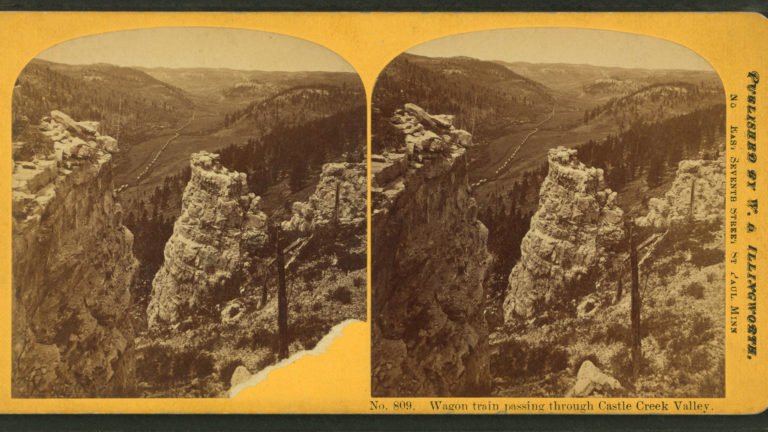This was not the usual military expedition. The Seventh Cavalry band played for the troops in the mornings as they broke camp and played concerts in the evenings. Troopers leaned from their horses to pick flowers. The large hospital tent served as a dining room for Custer and his staff. Wine bottles visible in Illingworth’s photographs indicate they dined in civilized style.
Moving southwest, the expedition reached the Belle Fourche River on July 18. Custer and his party were amazed by the Hills. June was, and still is, the best month to be in the area. The expedition marveled at the trees, sheer cliffs, clear streams, grasses, flowers, and early summer climate of the area. Interestingly, they found few signs of Indian habitation. Custer scaled the 6,000-foot Inyan Kara, carving his name and date at the top, as he did on other lofty locations in the Hills. W. H. Illingworth set up his bulky equipment to photograph the string of white-topped wagons stretching along the valleys, wagons that would have to be lowered into gulches by ropes and chains that dug deep grooves into sturdy trees.
In mid-July, the expedition was camped in an open area east of the present town of Custer. Horatio Ross made the initial discovery of gold along French Creek. Custer wasted little time in dispatching the news to Fort Laramie, Wyoming Territory. Bearing the news to the outside world, courier Charley Reynolds made the 115-mile ride to Fort Laramie in four nights, hiding during the day to escape detection by any hostile Indians. From Fort Laramie, Custer’s reports were telegraphed to General Terry in St. Paul. After reading through descriptions of beautiful valleys filled with lush grasses, flowing streams of clear, cold water, wild berries and flowers, Terry finally arrived at the core of the 3,500-word dispatch:
“… gold has been found at several places, and it is the belief of those who are giving their attention to this subject that it will be found in paying quantities. I have on my table forty or fifty small particles of pure gold…most of it obtained today from one panful of earth.”
Newspapers in the United States, and around the world, spread the word of the gold discovery by the last week of July. Back at French Creek, Horatio Ross, 20 men, and Sarah Campbell drew up papers and staked their claim for District No. l, the Custer Mining Company, before the expedition headed north. The expedition explored the central and northern Black Hills, and then exited the Hills near Bear Butte.
The nearly 1,200-mile expedition took sixty days, arriving back at Fort Abraham Lincoln on August 30, 1874. By the time Custer returned, the Black Hills gold rush was on. In Cheyenne and Virginia City, Sioux City and Sidney, Helena and Bismarck, groups of gold-hungry men prepared for prospecting trips into the forbidden Black Hills. (See related story about the Black Hills treaty and the gold rush 1874-1876)
George Armstrong Custer didn’t live to see the full impact of his 1874 expedition, nor did Tom and Boston Custer, or scouts Bloody Knife and Charley Reynolds. Many of the same men who accompanied him into the Black Hills died with Custer at the Battle of the Little Bighorn two years later.

